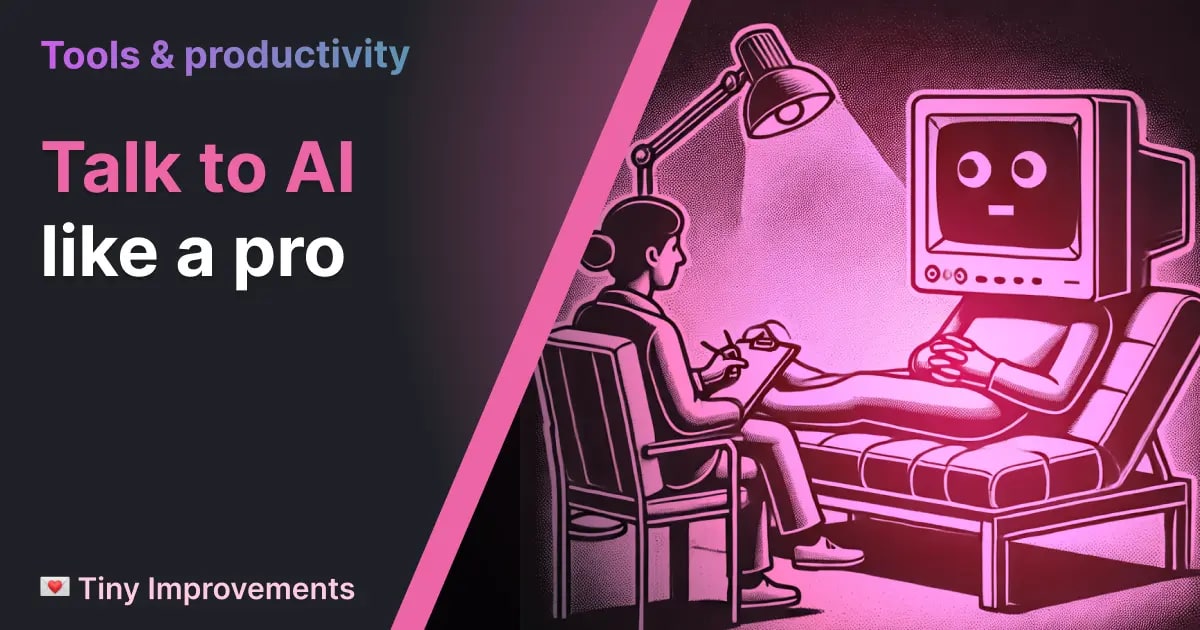
The Big Idea
Talking to AI is a lot like talking to people... except for all the ways that it isn't. It's a skill worth honing, and not a replacement for thinking.
From 2020 to 2022, I worked at Google.
I was on the Google Assistant team, in an era where "hey alexa" and "hey google" weren't new ideas. ChatGPT had not been released yet, and in general, the public was not aware of AI; "LLM" was far from a household term.
Funny enough, the dev product that my team was promoting was called "conversational actions" -- back then, "conversations" were predetermined - whether you realized it or not, you were following a scripted series of questions, and Google Assistant was a clever way to trigger actions.
In that time before LLMs took over, I noticed a funny pattern: people would talk to their assistant like a robot. They'd slow down, speak in weird, clipped phrases, almost like they were trying to sound like the assistant itself. It reminded me of how people adjust their speech when talking to someone who doesn't speak their language.
Fast forward to today: people are speaking to LLMs much more naturally. Conversations with AI feel more convincing, but the reality is that the LLM is still just a tool. It's up to you to do the thinking.
Of course, LLMs are getting better all the time, and the tools will continue to get better. There's still a real skill in knowing how to talk to your LLM. Done well, it can be a powerful extension of your thinking. Done poorly, it's a waste of time.
After a bit of reflection, here's the pattern I've adopted for working with AI tools:
Provide Context (More is Better)
Once upon a time - like, two years ago - LLMs had tiny context windows. They were only able to process a few paragraphs of information at a time. Now there's loads more headroom. Most modern models can handle essays, transcripts, full articles, and more. The more context you provide, the better the results.
Here's how I set mine up for success:
- Tell it who you are. Your background, goals, and what expertise you expect from it.
- Define the task. Are you brainstorming? Writing? Editing? Summarizing?
- Give it sources. If it can read the web, provide links. Otherwise, copy/paste key quotes or references.
- Set guardrails. Be explicit about what you do and don't want. Examples:
- "Be concise."
- "Avoid jargon."
- "Don't mention XYZ."
- "Your audience is nontechnical."
Iterate and Customize
You'll get better results if you tweak your prompts while working, and you should save what works, and refine it over time.
- Save what works. If you get a great response, refine it into a reusable prompt.
- Use different prompts for different goals. You wouldn't write a social post the same way as an executive summary. You may want to have separate prompts for copywriting for social media, writing execustive summaries, or brainstorming on SEO keywords, for example.
- Redo / Retry / Resubmit. LLMs aren't deterministic: if you submit the same set of instructions multiple times, you'll get different results. If it misses the mark, tweak the input and try again.
I think it's also a good idea to regularly try different models and tools - what does Claude do better than Gemini? You'll never know if you don't experiment with the tools. Don't get lazy, and don't blind yourself to what's out there - it's all changing very quickly right now.
Don't Get Lazy
An LLM is a tool - not a replacement for thinking.
I'll admit, I go into a bit of an existential spiral when I think about the future of communication - do we want to winnow down our existence to LLMs talking to each other? I certainly hope not. All the same, these tools are really useful for brainstorming, editing, and revising your writing, and they're not going away.
You're still the expert (ideally). It's your job to check facts, refine tone, and ensure the final product sounds like you. In my opinion, a big part of that work means that you should treat your LLMs like an assistant, not a crutch.
Edit the output - make it sound like you!
TL;DR
- More context = better output.
- Experiment, tweak, and refine your prompts.
- Never stop thinking - you're still the one with the expertise.
Your inbox shouldn't slow you down.
Superhuman's AI-powered features-Instant Summarize, Smart Replies, and Ask AI-help you fly through email, reclaiming at least 4 hours every week.
That's 4 extra hours to build, think, and focus on what actually matters.
📩 Tiny Improvements readers get their first month free.
Stick these in your brain's context
I'm a firm believer that we should always be learning. Don't rely on AI to do all your thinking. Here's a couple things I found this week that you might enjoy:
-
Ranking Paradoxes is a YouTube video from Chalk Talk, which goes discusses the complexity and counterintuitivity of philosophical and mathematical paradoxes.
-
I'm still very much into 3D printing nerdery - and this recent video from Make Anything on multi-texture prints shares a really cool new technique for making prints more visually interesting.

